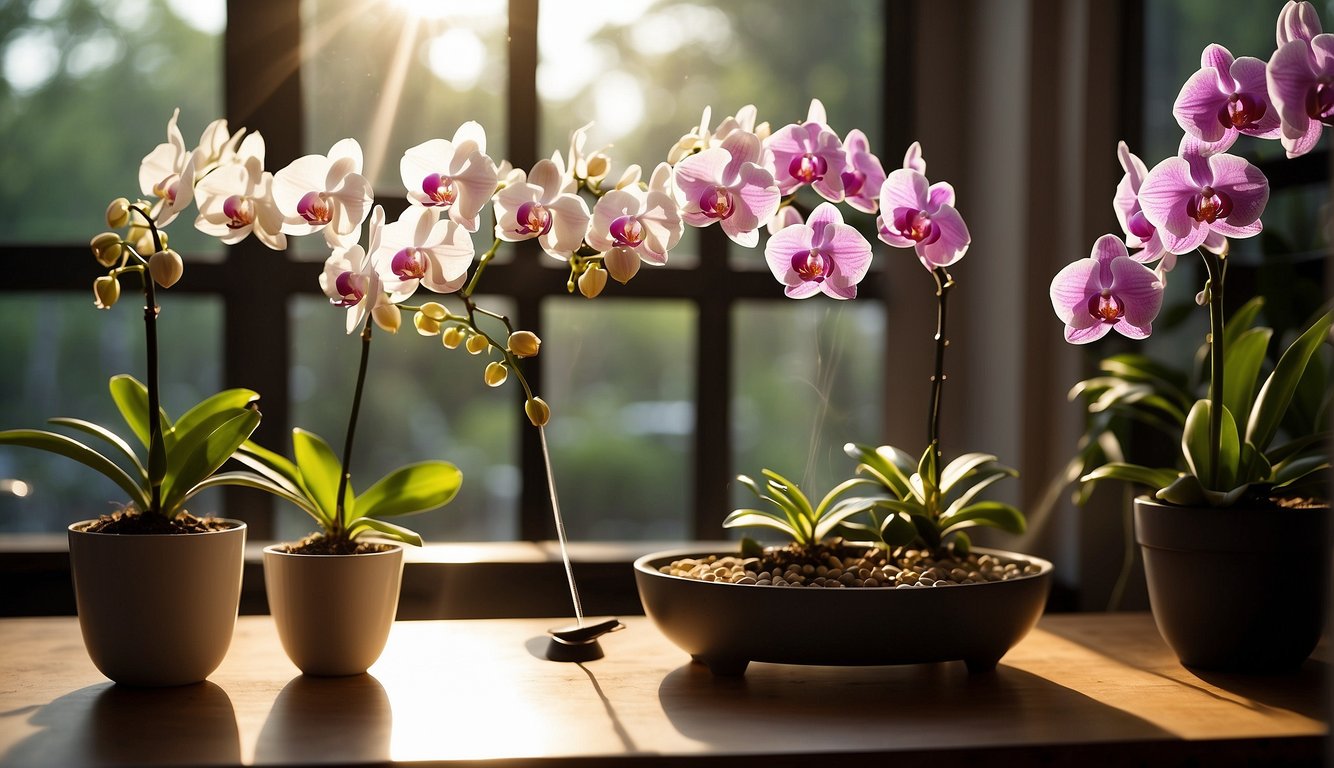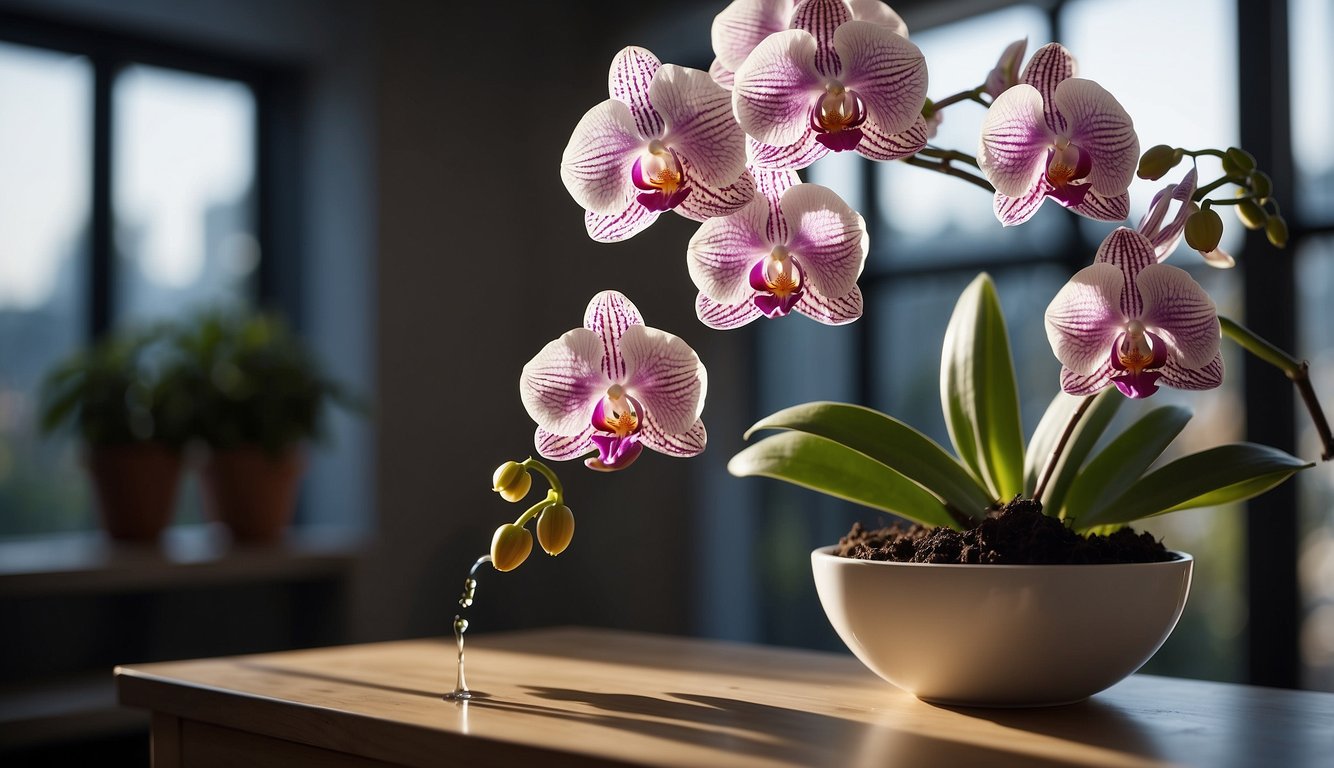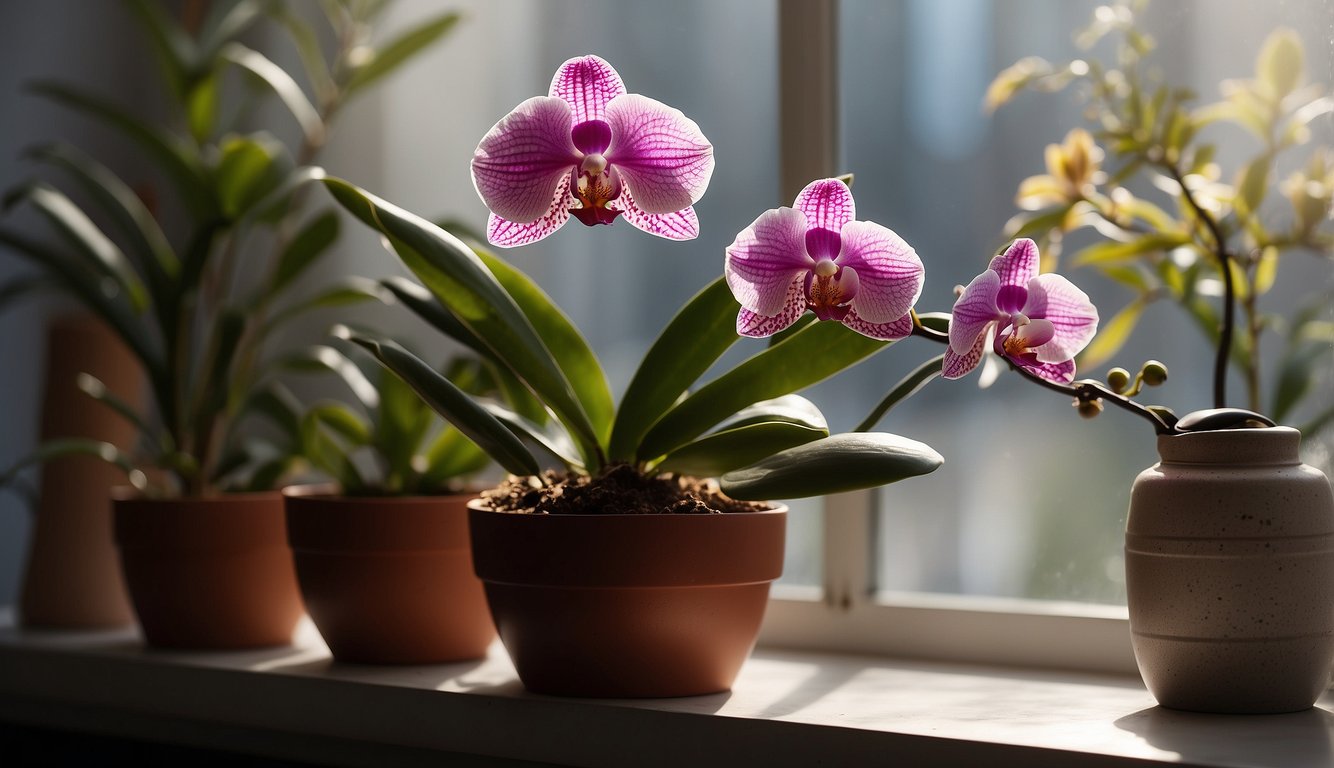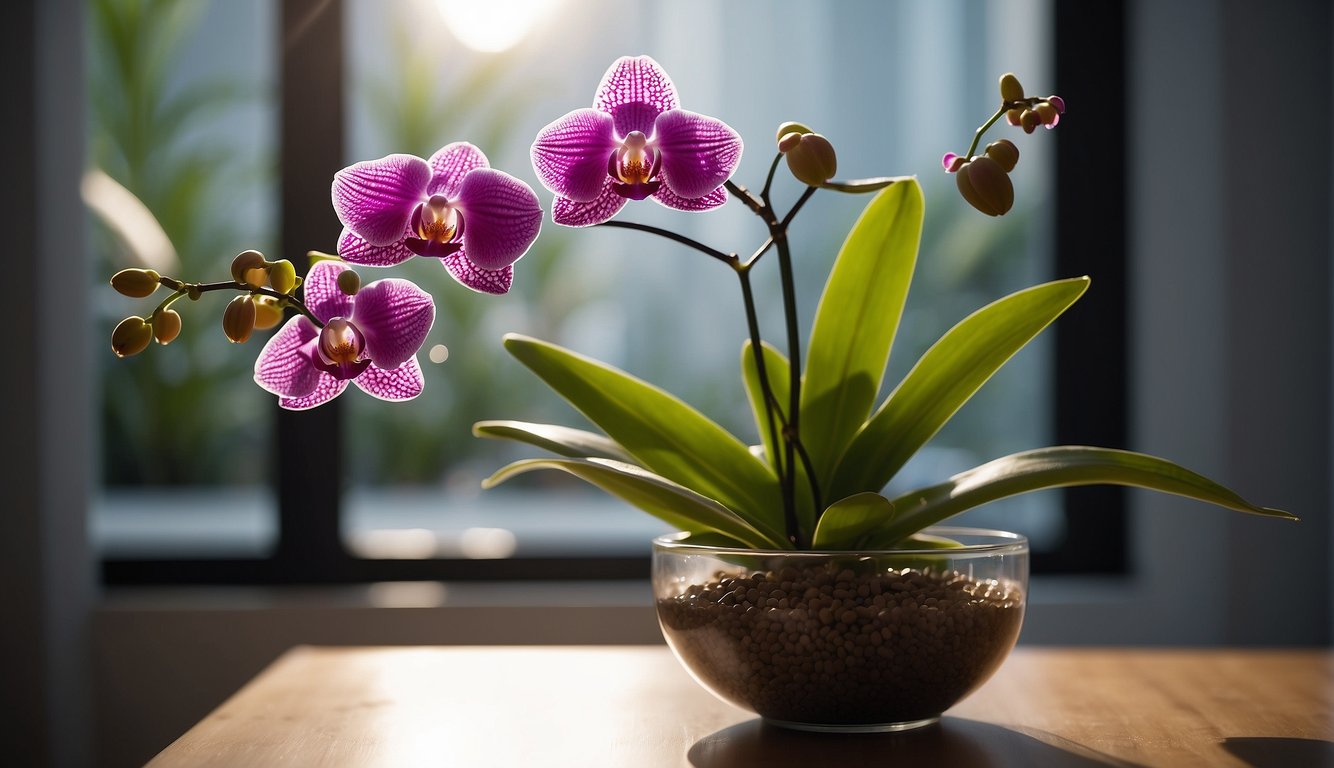TheHerbProf.com is a treasure trove of knowledge for those interested in natural healing and herbal remedies. The website is run by Paul Johnston MD. A naturopathic who has not only received extensive education in the field but also has personal experience in self-healing.
Getting orchids to rebloom can be a challenging task, but with the right care, it’s definitely achievable. Orchids are beautiful and exotic plants that are often used as decorative houseplants. They have a reputation for being difficult to care for, but with a little bit of knowledge and patience, anyone can get their orchids to rebloom.
The first step in getting orchids to rebloom is to understand their natural growing conditions. Orchids are native to tropical regions, and they require a warm and humid environment to thrive. They also need a lot of light, but not direct sunlight. Understanding these conditions is crucial in providing the right environment for your orchids to grow and rebloom. Proper watering and fertilization are also important factors to consider when caring for orchids. Overwatering can lead to root rot, while under-watering can cause the plant to dry out. Fertilizing your orchids regularly can help promote healthy growth and encourage blooming.
Understanding Orchid Reblooming – How to Get Orchids to Rebloom?
As an orchid enthusiast, I know how exciting it is to see these beautiful plants bloom. However, getting them to rebloom can be a bit challenging. In this section, I will share my knowledge about orchid reblooming and provide tips on how to get your orchids to rebloom successfully.
Orchid Growth Cycle – How to Get Orchids to Rebloom?
Before we dive into the specifics of orchid reblooming, it’s important to understand the growth cycle of these plants. Orchids have a unique growth cycle that consists of active growth and dormancy periods. During the active growth period, the orchid produces new leaves, roots, and flowers. Once the active growth period ends, the orchid enters a dormant period where it conserves energy and prepares for the next active growth period.
Signs of Orchid Readiness for Reblooming
To get your orchids to rebloom, you need to know when they are ready. One of the most important signs of orchid readiness for reblooming is the presence of green leaves and a healthy spike. If the leaves and spike are still green, it’s possible to rebloom the orchid. However, if the leaves and spike are yellow or brown, it’s a sign that the orchid is not ready for reblooming.
Another sign of orchid readiness for reblooming is the presence of new growths. New growths indicate that the orchid is healthy and actively growing. If your orchid has new growths, it’s a good sign that it’s ready to rebloom.
Understanding the growth cycle of orchids and knowing the signs of orchid readiness for reblooming are crucial to getting your orchids to rebloom successfully. By following the tips in the next section, you can help your orchids enter the active growth period and produce beautiful flowers once again.
Optimal Environmental Conditions – How to Get Orchids to Rebloom?

As an orchid enthusiast, I have learned that providing optimal environmental conditions is crucial to getting orchids to rebloom. Here are the three key factors to consider:
Light and Placement – How to Get Orchids to Rebloom?
Orchids require bright, indirect light to thrive. Placing them in a south-facing window is ideal, but be sure to protect them from direct sunlight, which can scorch their leaves. If you don’t have a south-facing window, you can use artificial lighting to supplement natural light.
Temperature and Humidity
Orchids prefer warm, humid environments. The ideal temperature range is between 65°F and 75°F during the day and 60°F to 65°F at night. To maintain the humidity levels, consider placing a tray of water near the orchids or using a humidifier.
Watering Requirements
Overwatering is a common mistake when it comes to caring for orchids. It’s important to let the soil dry out between waterings, as orchids are susceptible to root rot. Depending on the type of orchid, you may need to water them once a week or every two weeks. It’s also important to use room-temperature water and avoid getting water on the leaves or flowers.
By providing the right environment for your orchid, you can increase the chances of it reblooming. Remember to keep your orchid in a cool location with indirect light, maintain proper humidity levels, and water it correctly. With a little patience and care, you can enjoy beautiful blooms year after year.
Orchid Care and Maintenance – How to Get Orchids to Rebloom?

As an orchid enthusiast, I know that proper care and maintenance are crucial for getting orchids to rebloom. Here are some essential tips that can help keep your orchids healthy and encourage them to bloom:
Pruning and Cleaning
Pruning and cleaning are crucial for orchid care. After the flowers have faded, it is essential to remove the flower spike to encourage the growth of new spikes. Cut the spike just above the node where the first flower bloomed. Also, remove any yellow or dead leaves and trim off any brown or damaged roots. Cleaning the leaves with a damp cloth or sponge will help remove dust and improve photosynthesis.
Fertilizing and Feeding – How to Get Orchids to Rebloom?
Orchids need proper nutrients to grow and bloom. Fertilizers are an essential part of orchid care. Fertilize your orchids regularly with a balanced orchid fertilizer that has equal amounts of nitrogen, phosphorus, and potassium. Apply the fertilizer at half-strength every two weeks during the growing season and reduce it to once a month during the dormant season. In addition to fertilizers, feeding your orchids with a weak solution of fish emulsion or seaweed extract can help provide the necessary nutrients.
Repotting for Healthier Growth
Repotting orchids is necessary when the potting mix breaks down, the roots outgrow the pot, or the plant becomes too large. Repot your orchids every one to two years using a fresh potting mix that provides proper drainage. Use a pot with drainage holes to prevent waterlogging, which can lead to root rot. When repotting, remove any old potting mix and trim off any dead or damaged roots. Place the orchid in the new pot, fill it with fresh potting mix, and water the plant thoroughly.
By following these essential tips for orchid care and maintenance, you can keep your orchids healthy and encourage them to bloom. Remember to always check the specific requirements of your orchid species, as they may have unique needs.
Encouraging Orchid to Rebloom – How to Get Orchids to Rebloom?

As an orchid enthusiast, I know how rewarding it is to see your plant bloom again. Here are some tips to encourage your orchid to rebloom.
Stimulating New Flower Spikes
One way to stimulate new flower spikes is to cut back the old stem after the final flower has fallen. This will encourage the orchid to produce a new spike. Make sure to sterilize your cutting tool before and after cutting to prevent the spread of diseases.
Another way to stimulate new spikes is to provide the orchid with the right amount of light and temperature. Most orchids require bright, indirect light and a temperature range of 60-80°F (15-27°C) to bloom. Avoid exposing your orchid to direct sunlight as it can damage the leaves and flowers.
Managing Bloom Cycles – How to Get Orchids to Rebloom?
Orchids have a natural bloom cycle, and it is important to understand it to encourage reblooming. Most orchids bloom once a year, and the blooming season depends on the species. For example, Phalaenopsis orchids usually bloom in the winter or early spring.
To manage the bloom cycle, make sure to provide your orchid with the right amount of water and nutrients. Overwatering can lead to root rot, which can prevent your orchid from blooming. Use a well-draining potting mix and water your orchid only when the top inch of the soil is dry.
Troubleshooting Common Issues
Sometimes, even with the right care, orchids may not bloom. Here are some common issues and how to troubleshoot them:
- No new flower spikes: If your orchid has not produced a new spike after cutting back the old stem, it may be due to insufficient light or temperature. Try moving your orchid to a brighter spot or adjusting the temperature.
- Flower buds drop off: If your orchid produces flower buds but they drop off before blooming, it may be due to overwatering or underwatering. Make sure to water your orchid properly and adjust the watering schedule as needed.
- No flowers: If your orchid produces leaves but no flowers, it may be due to insufficient light or nutrients. Try fertilizing your orchid with a balanced fertilizer and providing it with more light.
With these tips, you can encourage your orchid to rebloom and enjoy its beautiful flowers again and again.
Specific Orchid Species Care – How to Get Orchids to Rebloom?

When it comes to orchids, different species have different care requirements. In this section, I will discuss the care requirements for some of the most popular orchid species.
Phalaenopsis Orchid Reblooming – How to Get Orchids to Rebloom?
Phalaenopsis orchids, also known as moth orchids, are one of the most popular orchid species due to their beautiful and long-lasting flowers. To encourage your Phalaenopsis orchid to rebloom, there are a few things you can do:
- Cut back the flower spike: Once the flowers have faded, cut the flower spike just above the node where the first flower bloomed. This will encourage the orchid to produce a new spike and more flowers.
- Provide proper lighting: Phalaenopsis orchids prefer bright, indirect light. Place your orchid near a window where it will receive plenty of light but avoid direct sunlight.
- Maintain proper humidity: Phalaenopsis orchids are tropical plants and require high humidity to thrive. You can increase humidity by placing a tray of water near the orchid or by using a humidifier.
- Water properly: Phalaenopsis orchids prefer to dry out slightly between waterings. Water your orchid when the potting mix feels dry to the touch, but be careful not to overwater.
Caring for Vanda and Dendrobium
Vanda and Dendrobium are two other popular orchid species that require slightly different care than Phalaenopsis orchids. Here are some tips for reblooming these orchids:
- Provide proper lighting: Vanda and Dendrobium orchids prefer bright, direct light. Place your orchid near a window where it will receive plenty of light but avoid direct sunlight during the hottest part of the day.
- Water properly: Vanda and Dendrobium orchids prefer to stay slightly moist. Water your orchid when the potting mix feels dry to the touch, but be careful not to let it dry out completely.
- Provide proper humidity: Vanda and Dendrobium orchids also require high humidity to thrive. You can increase humidity by placing a tray of water near the orchid or by using a humidifier.
- Fertilize regularly: Vanda and Dendrobium orchids require regular fertilization to produce new growth and flowers. Use a balanced orchid fertilizer and follow the instructions on the package for best results.
Overall, each orchid species has its own unique care requirements. By following these tips, you can encourage your orchids to rebloom and thrive.
Aftercare Following Reblooming

Once your orchid has rebloomed, it is important to continue providing it with proper care to ensure that it stays healthy and continues to produce beautiful blooms. Here are some tips for aftercare following reblooming:
Trimming the Stem – How to Get Orchids to Rebloom?
After the last flower has fallen off, you should trim the stem to about one inch above the node closest to the base of the plant. This will encourage new growth and potentially new blossoms. If the stem is brown or yellow, you should cut it all the way back to the base of the plant.
Staking
If your orchid has grown tall and lanky, you may need to stake it to prevent it from falling over. You can use bamboo stakes or other materials to support the plant. Be sure to tie the orchid loosely to the stake, so as not to damage the stem or aerial roots.
Aerial Roots
Orchids often have aerial roots that grow above the soil. These roots are important for the plant’s health and should not be trimmed. Instead, you can gently guide them back into the potting mix or attach them to a stake.
Leaf Color and New Leaf Growth – How to Get Orchids to Rebloom?
Healthy orchid leaves should be a bright green color. If the leaves are yellow or brown, this may indicate a problem with watering or fertilizing. New leaves should also be growing at a regular schedule. If your orchid is not producing new leaves, it may need more light or nutrients.
Watering and Fertilizing
After reblooming, you should continue to water your orchid on a regular schedule. Be sure to let the potting mix dry out slightly between waterings, as overwatering can lead to root rot. Fertilizing should also be done on a regular schedule, using a balanced orchid fertilizer.
Overall, aftercare following reblooming is crucial for the health and longevity of your orchid. By following these tips and providing your plant with proper care, you can enjoy beautiful blooms year after year.
How to Get Orchids to Rebloom?
Let’s delve into the world of orchids and the art of getting them to rebloom!
Firstly, we have light. Orchids need just the right amount of light to rebloom. Not too much, not too little, but just right!
Next, let’s talk about temperature. Orchids love a slight drop in temperature at night. It helps trigger the blooming process!
Ever heard of fertilizer? A balanced orchid fertilizer can give your orchid the nutrients it needs to rebloom.
And let’s not forget patience. Orchids can take their sweet time to rebloom. But trust me, the wait is worth it when you see those stunning blooms!
Remember, folks, gardening is all about patience and love. So, let’s keep planting, keep nurturing, and keep enjoying the beauty of our plants!
For more orchid wisdom, don’t forget to visit my homepage at theherbprof.com. Keep those green thumbs up!
References – How to Get Orchids to Rebloom?
Little Herb Encyclopedia, by Jack Ritchason; N.D., Woodland Publishing Incorporated, 1995
The Ultimate Healing System, Course Manual, Copyright 1985, Don Lepore
Planetary Herbology, Michael Tierra, C.A., N.D., Lotus Press, 1988
Handbook of Medicinal Herbs, by James A. Duke, Pub. CRP Second Edition 2007
The Complete Medicinal Herbal, by Penelope Ody, Published by Dorling Kindersley
Check the Following Articles!
Can You Eat Thyme Stems? A Comprehensive Guide
How to Get Rid of Rhubarb: A Comprehensive Guide
Hoya Plant Bloom: Triggering and Maintaining Blossoms
Frequently Asked Questions – How to Get Orchids to Rebloom?

What type of fertilizer should I use to encourage my orchid to rebloom?
Fertilizing orchids is essential for their growth and blooming. The best type of fertilizer for orchids is a balanced fertilizer with a 20-20-20 or 10-10-10 ratio of nitrogen, phosphorus, and potassium. You should fertilize your orchid every two weeks during the growing season, which is typically from spring to fall. During the winter months, you should fertilize your orchid once a month.
What are the signs that an orchid is preparing to bloom again?
The signs that an orchid is preparing to bloom again include the growth of new leaves, the appearance of new roots, and the emergence of a new flower spike. Orchids also require a period of dormancy, during which the plant may appear to be dead or dying. However, if the leaves and roots are still green and healthy, there is a good chance that the orchid will bloom again.
Can an orchid rebloom from the same stem, and how can I facilitate this?
Yes, an orchid can rebloom from the same stem. To facilitate this, you should cut the stem just above the node where the last flower bloomed. This will encourage the orchid to produce a new flower spike from the same stem. However, if the stem is brown and dry, it is best to cut it off completely and wait for a new spike to grow from the base of the plant.
What environmental conditions are needed to trigger an orchid to rebloom indoors?
Orchids require specific environmental conditions to bloom. They need bright, indirect light, high humidity, and good air circulation. You should also maintain a consistent temperature of between 60 and 80 degrees Fahrenheit. If your orchid is not blooming, it may be because it is not receiving enough light or is being exposed to drafts or extreme temperatures.
How can I promote the growth of a new spike on my orchid?
To promote the growth of a new spike on your orchid, you should ensure that it is getting enough light, water, and nutrients. You should also make sure that the plant is not being exposed to extreme temperatures or drafts. If your orchid is still not producing a new spike, you may need to cut the old spike off and wait for a new one to grow.
Is continuous blooming possible for orchids, and how can it be achieved?
Continuous blooming is possible for orchids, but it requires careful attention to their care and maintenance. To achieve continuous blooming, you should ensure that your orchid is getting enough light, water, and nutrients. You should also make sure that the plant is not being exposed to extreme temperatures or drafts. Additionally, you should fertilize your orchid regularly and repot it every two years to ensure that it has enough space to grow. With proper care, your orchid can bloom continuously for many years.


